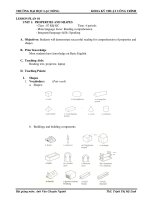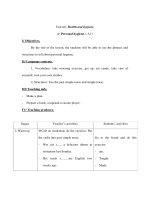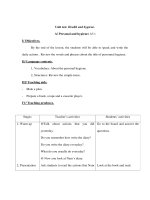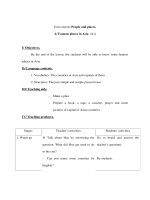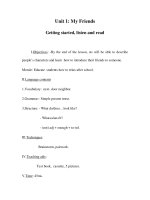UNIT 1 tenses and Tense
Bạn đang xem bản rút gọn của tài liệu. Xem và tải ngay bản đầy đủ của tài liệu tại đây (106.39 KB, 12 trang )
UNIT 1: TENSES
A.
Knowledge
I.
Present
1. Present Simple
a. Structure:
Type
Affirmative
Negative
Interrogativ
e
Structure
Subject + Verb/ Verb(s)/ Verb(es) + Object
Subject + don’t / doesn’t + Verb + Object
Do/ Does + Subject + Verb + Object
Example:
- I go to work at 9 a.m every day
- I don’t have enough money to buy this bag
- Do we have to get up early every day?
b. Use
- Talk about hobbies/ habit
Ex: I go to work by bike every morning
- Talk about facts/ truth
Ex: If you heat water to 100 degree celcius, it boils
- Talk about permanent situations
Ex: My parents own a restaurant
c. Signals
every
always
usually
2. Present continuous
a. Structure:
Affirmative
Negative
Interrogativ
e
Subject + to be + V-ing + Object
Subject + to be + not + V-ing + Object
To be + Subject + V-ing + Object?
Example:
- I am studying now
- I am not watching the TV now
- Are you working at the moment?
often
b. Use
- Talk about actions happening at the moment of speaking
Ex: Look! It is raining
They are doing homework at the moment
c. Signals
At the moment
Now
Currently
At present
3. Present Perfect
a. Structure
Affirmative
Negative
Interrogative
Subject + have/ has + Vpp2 + Object
Subject + have/ has + not + Vpp2 + Object
Have/ has + Subject + Vpp2 + Object
b. Use
- Talk about something that happened in the past and continues in the present
Ex: I have worked for this company for 2 years
We have known each other for 5 months
c. Signals
recently
So far
lately
just
yet
for
already
since
II.
Past
1. Past Simple
a. Structure
Affirmative
Negative
Interrogative
Subject + Verb (ed/ p1) + Object
Subject + did + not + Verb + Object
Did + Subject + Verb + Object?
b. Use
- Talk about events in the past
Ex: I bought my cell phone 2 years ago
I received this gift last month
c. Signals
Last…
III.
ago
Future
In…
yesterday
1. Future Simple
a. Structure
Affirmative
Negative
Interrogative
Subject + will + Verb + Object
Subject + will + not + Verb + Object
Will + Subject + Verb + Object?
b. Use
- Talk about predictions, usually based on our opinions or our past experience
Ex: I think it will be extremely hot there
Talk about something we decide to at the time of speaking
Ex:
A: how about going to the cinema this weekend?
B : Okay, I will buy the ticket
-
c. Signals
In ….
next
In the future
tomorrow
2. Be going to
a. Structure
Affirmative
Negative
Interrogative
Subject + to be + going to + Verb + Object
Subject + to be + not + going to + Verb + Object
To be + Subject + going to + Verb + Object?
b. Use
- To talk about events in the future we have already thought about and intend to
do
Ex: I am going to have an exam next week
- Make prediction where there is present evidence
Ex: It is going to rain because the sky is cloudy now
c. Signals
In…
next
In the future
B.
tomorrow
Practice
Exercise 1: Fill the gap with correct words
1.
A.
2.
A.
3.
Harry often ……. books from the library
borrows
B. is borrowing
My grandfather …….. collecting stamps
Is loving
B. Are loving
She…… her friends at a bar right now
C. are borrowing
C. loves
A.
4.
A.
5.
A.
6.
A.
7.
A.
8.
A.
waiting
B. is waiting
C. waits
Nguyen Nhat Anh is a writer. He….. a short story about a dragon
Is writing
B. writes
C. are writing
I never….. home late
come
B. is coming
C. am coming
She usually…… much
Doesn’t talk
B. Don’t talk
C. Isn’t talking
You……… a lot since the last time I saw you
Changed
B. Have changed
C. Is changing
I………. the report yet
completed
B. haven’t completed
C. have already
completed
9. I ………..three books by the same author since the last month
A. Has read
B. Have read
C. read
10. Kate ……… a cup of coffee every morning
A. Is drinking
B. drinks
C. drink
Exercise 2: Choose the correct form of verbs
1. When we were seniors in our university, we (do) …………… many
presentations that were related to our major.
2. Smartphones (be) …………. not popular fifteen years ago.
3. Last year, I (go) ……….… on a trip to Ho Chi Minh City in my summer
vacation and that trip is the most memorable one that I have ever had.
4. He (use) ……….…. to be a very famous actor in the 1990s.
5. One of the most terrible natural disasters is the earthquake and tsunami that
(happen) ……………… in Japan in 2011.
6. I'm afraid I……………… (not/ be) able to come tomorrow.
7. Because of the train strike, the meeting ………………… (not/ take) place at 9
o'clock.
8. A: “Go and tidy your room.”
B: “Okay. I ……………… (do) it now!”
9. If it rains, we ……………… (not/ go) to the beach.
10. In my opinion, she ……………… (not/ pass) the exam.
11. A: “I'm driving to the party, would you like a lift?”
B: “Thank you but I …………………………..… (take) the bus.”
12. Look at the sky! It…………………………..…(rain) very heavily!
13. The company (hold) ……………….….………a very important meeting next
month.
14. According to the weather forecast, it ………………………...…… (not/ snow)
tomorrow.
15. I think I (go)……………….…………study abroad.
C.
Exam focus
Exercise 1: Line chart – Writing Task 1
The graph (1) ……………. (show) how many people (2) …………… (visit) three London
museums in the summer of 2013. Most visitors (3) ……………… (go) to the British
museum (4) ………… June and September. The number (5) …………….. (fluctuate)
between 500 and 750. By contrast, the Science Museum and the Natural History
Museum (6) ……………… (receive) fewer visitors. The number of people who visited the
Science Museum (7) ……………. (drop) gradually from 400 thousand to 300 from June to
August then (8) ………………. (rise) to 450 thousand (9) ……………. September. We
can (10) ……………. (see) that the trend for the Natural History Museum (11)
…………… (be) similar. There was a sharp drop in visitors from June to July. The
number (13) …………… (remain stable) in August and then (14)
………………. (increase) steadily in September.
Exercise 2:
The happiest country in the world
Children growing up in Costa Rica are surrounded by some of the most beautiful and
diverse landscapes in the world. Preserving tropical rainforests isn’t Costa Rica’s only
success, because the government also makes sure everyone has access to health-care
and education. So when the New Economics Foundation released its second Happy
Planet Index, Costa Rica came out number one. The index is a ranking of countries
based on their impact on the environment and the health and happiness of their
citizens.
According to Mariano Rojas, a Costa Rican economics professor, Costa Rica is a midincome country where citizens have plenty of time for themselves and for their
relationships with others. ‘A mid-income level allows most citizens to satisfy their
basic needs. The government makes sure that all Costa Ricans have access to
education, health and nutrition services.’ Costa Ricans, he believes, are not interested
in status or spending money to show how successful they are.
Created in 2008, the Happy Planet Index examines happiness on a national level and
ranks 143 countries according to three measurements: their citizens’ happiness, how
long they live (which reflects their health), and how much of the planet’s resources
each country consumes. According to researcher Saamah Abdallah, the
Index also measures the outcomes that are most important, and those are happy,
healthy lives for everyone.
Questions 1-6
Choose ONE WORD OR ONE NUMBER from the passage for each answer.
The Happy Planet Index
Year started: 1 ………………
Number of countries it lists: 2 ………….
Measures each country's happiness according to:
■ its effect on the 3 ………….. (i.e. the quantity of the Earth's 4 ………….. that it
uses);
■ the 5 ………… of the population (i.e. how long people live);
■ how happy its 6 ………………. are.
Exercise 3:
The world’s friendliest city
A team of social psychologists from California has spent six years studying the
reactions of people in cities around the world to different situations. The results show
that cities where people have less money generally have friendlier populations. Rio de
Janeiro in Brazil, which is often known for its crime, comes out top, and the capital of
Malawi, Lilongwe, comes third.
But what makes one city friendlier than another? The psychologists from California
State University say it has got more to do with environment than culture or
nationality.
They carried out a study into the way locals treated strangers in 23 cities around the
world. The team conducted their research through a series of tests, where they
dropped pens or pretended they were blind and needed help crossing the street.
The study concludes that people are more helpful in cities with a more relaxed way of
life such as Rio. While they were there, researchers received help in 93 percent of
cases, and the percentage in Lilong we was only a little lower. However, richer cities
such as Amsterdam and New York are considered the least friendly. Inhabitants of
Amsterdam helped the researchers in 53 percent of cases and in New York just 44
percent. The psychologists found that, in these cities, people tend to be short of time,
so they hurry and often ignore strangers.
Questions 1-5
Complete the table below.
Choose ONE WORD from the passage for each answer.
City
Rio de
Janeiro
Positive aspects
Negative aspects
• friendly inhabitants
• People don’t have
so much 2 …………..
• more 1 ………… lifestyle • Has reputation
for crime
Amsterdam • richer
People
% of help
received
(3)………….
Amsterdam: (5)
and New
York
• have little time
…………
• don’t pay attention
to (4)…………….
New York: 44%
HOMEWORK
Exercise 1:
1. I ……………. a great film yesterday. (see)
2. ………………….. a cheap laptop? (you ever buy)
3. Sue ………………. the flu last winter. (have)
4. A few days ago, we ……………… to his uncle. (drive)
5. Bob……………………. well last night. (sleep)
6. I ………………… a letter from her two days ago. (get)
7. The .……………. in Germany. (already arrive)
8. I …………….. him last Monday. (meet)
9. She ……………… yet. (not wake up)
10. I ………….. her since last Thursday. (not meet)
Exercise 2: Simple present – present progressive – simple past? Fill in the correct
tense.
Every summer our class…………. (go) on a short trip. Last year we ………….. (go)
to a zoo. Our teacher …………. (be) very nervous. Teachers ……….. (be) often
nervous on a school trip. But why? We ………. (not understand) that.
I ………….. (take) lots of photos of a baby elephant with my cell phone.
"Why you ………… (not take) photos of other animals, too?" my
friend …………. (ask) me. But I …………… (not want) to take photos of other
animals. I …………. (want) to take photos of all my friends. They ………….. (have)
some bananas and …………… (show) them to the gorillas.
"What ………… you …………. (do) there? Come to me!" our teacher …… (shout).
We …………(find) a nice place for a picnic. But nobody ………. (eat) a banana, but
the gorillas …… (have) a nice lunch that day. It ………. (be) a great day at the zoo,
and we …………. (have) a lot of fun.
Exercise 3:
The line graph …………….. (demonstrate) the percentage of visitors to four sights in
Scotland capital, Edinburgh between 1980 and 2010. The four attractions are
Aquarium, Castle, Zoo, and Festival.
Overall, the Festival and the Aquarium had downward trends while the Castle and the
Zoo…………..(see) more visitors at the end of the 30-year period than at the
beginning. The slightest changes occurred in the Festival figures while the most
significant fluctuations were seen in the numbers of people visiting the Aquarium.
The Aquarium and the Zoo saw similar developments until 2000, starting at 20% and
10% respectively and experiencing a series of rises and falls. From 2000 to 2010, the
proportion of visitors to the Aquarium …………(go down)dramatically to about 8%,
resulting in the lowest number among the four sights. Meanwhile, the Zoo figures
…………(rise) sharply ending the interval at 10%.
Although having a downward trend, the Festival’s numbers …………..(decrease)
slightly by only about 5%, which made it the second most popular place among
tourists in 2010. In contrast, Castle rose in popularity reaching a peak of almost 45%
in 1995 and becoming number one attraction with just over 30% of visitors at the end
of the period.
Exercise 4:
Reducing the Effects of Climate Change
B
Geo-engineering; has been shown to work, at least on a small localised scale. For
decades, MayDay parades in Moscow have taken place under clear blue skies, aircraft
having deposited dry ice, silver iodide and cement powder to disperse clouds. Many of
the schemes now suggested look to do the opposite, and reduce the amount of sunlight
reaching the planet. The most eye-catching idea of all is suggested by Professor Roger
Angel of the University of Arizona. His scheme would employ up to 16 trillion minute
spacecraft, each weighing about one gram, to form a transparent, sunlight-refracting
sunshade in an orbit 1.5 million km above the Earth. This could, argues Angel, reduce
the amount of light reaching the Earth by two per cent.
C
The majority of geo-engineering projects so far carried out — which include planting
forests in deserts and depositing iron in the ocean to stimulate the growth of algae have focused on achieving a general cooling of the Earth. But some look specifically
at reversing the melting at the poles, particularly the Arctic. The reasoning is that if
you replenish the ice sheets and frozen waters of the high latitudes, more light will be
reflected back into space, so reducing the warming of the oceans and atmosphere.
D
The concept of releasing aerosol sprays into the stratosphere above the Arctic has
been proposed by several scientists. This would involve using sulphur or hydrogen
sulphide aerosols so that sulphur dioxide would form clouds, which would, in turn,
lead to a global dimming. The idea is modelled on historic volcanic explosions, such
as that of Mount Pinatubo in the Philippines in 1991, which led to a short-term
cooling of global temperatures by 0.5 °C. Scientists have also scrutinised whether it's
possible to preserve the ice sheets of Greenland with reinforced high-tension cables,
preventing icebergs from moving into the sea. Meanwhile in the Russian Arctic, geoengineering plans include the planting of millions of birch trees. Whereas the -regions
native evergreen pines shade the snow an absorb radiation, birches would shed their
leaves in winter, thus enabling radiation to be reflected by the snow. Re-routing
Russian rivers to increase cold water flow to ice-forming areas could also be used to
slow down warming, say some climate scientists.
Questions 4-10
Complete the table below.
Choose ONE WORD from the passage for each answer. Write your answers in
boxes 4-10 on your answer sheet.
GEO-ENGINEERING PROJECTS
Procedure
put a large number of tiny
Aim
to create a 4 …………………. that would
spacecraft into orbit far above
Earth
reduce the amount of light reaching Earth
place 5 ………………. in the sea
to encourage 6 ………………. to form
release aerosol sprays
to create 7 ……………..that would reduce
the amount of light reaching Earth
into the stratosphere
fix strong 8 ………………
to prevent icebergs moving into the sea
to Greenland ice sheets
plant trees in Russian Arctic
that would lose their leaves
to allow the 9 ……………. to reflect
radiation
in winter
change the direction of
10 ………..
to bring more cold water into ice-forming
areas
Exercise 5:
The story of silk
The history of the world’s most luxurious fabric, from ancient China to the present
day
Silk is a fine, smooth material produced from the cocoons - soft protective shells - that
are made by mulberry silkworms (insect larvae). Legend has it that it was Lei Tzu,
wife of the Yellow Emperor, ruler of China in about 3000 BC, who discovered
silkworms. One account of the story goes that as she was taking a walk in her
husband’s gardens, she discovered that silkworms were responsible for the destruction
of several mulberry trees. She collected a number of cocoons and sat down to have a
rest. It just so happened that while she was sipping some tea, one of the cocoons that
she had collected landed in the hot tea and started to unravel into a fine thread. Lei
Tzu found that she could wind this thread around her fingers. Subsequently, she
persuaded her husband to allow her to rear silkworms on a grove of mulberry trees.
She also devised a special reel to draw the fibres from the cocoon into a single thread
so that they would be strong enough to be woven into fabric. While it is unknown just
how much of this is true, it is certainly known that silk cultivation has existed in China
for several millennia.
Originally, silkworm farming was solely restricted to women, and it was they who
were responsible for the growing, harvesting and weaving. Silk quickly grew into a
symbol of status, and originally, only royalty were entitled to have clothes made of
silk. The rules were gradually relaxed over the years until finally during the Qing
Dynasty (1644—1911 AD), even peasants, the lowest caste, were also entitled to wear
silk. Sometime during the Han Dynasty (206 BC-220 AD), silk was so prized that it
was also used as a unit of currency. Government officials were paid their salary in
silk, and farmers paid their taxes in grain and silk. Silk was also used as diplomatic
gifts by the emperor. Fishing lines, bowstrings, musical instruments and paper were
all made using silk. The earliest indication of silk paper being used was discovered in
the tomb of a noble who is estimated to have died around 168 AD.
Questions 1-5
Complete the notes below.
Choose ONE WORD ONLY from the passage for each answer.
Write your answers in boxes 1-9 on your answer sheet.
Early silk production in China
• Around 3000 BC, according to legend:
- silkworm cocoon fell into emperor’s wife’s 1 ……………..
- emperor’s wife invented a 2………….. to pull out silk fibres
•
Only 3 ………….. were allowed to produce silk
•
Only 4 …………. were allowed to wear silk
•
Silk used as a form of 5 ……………….


